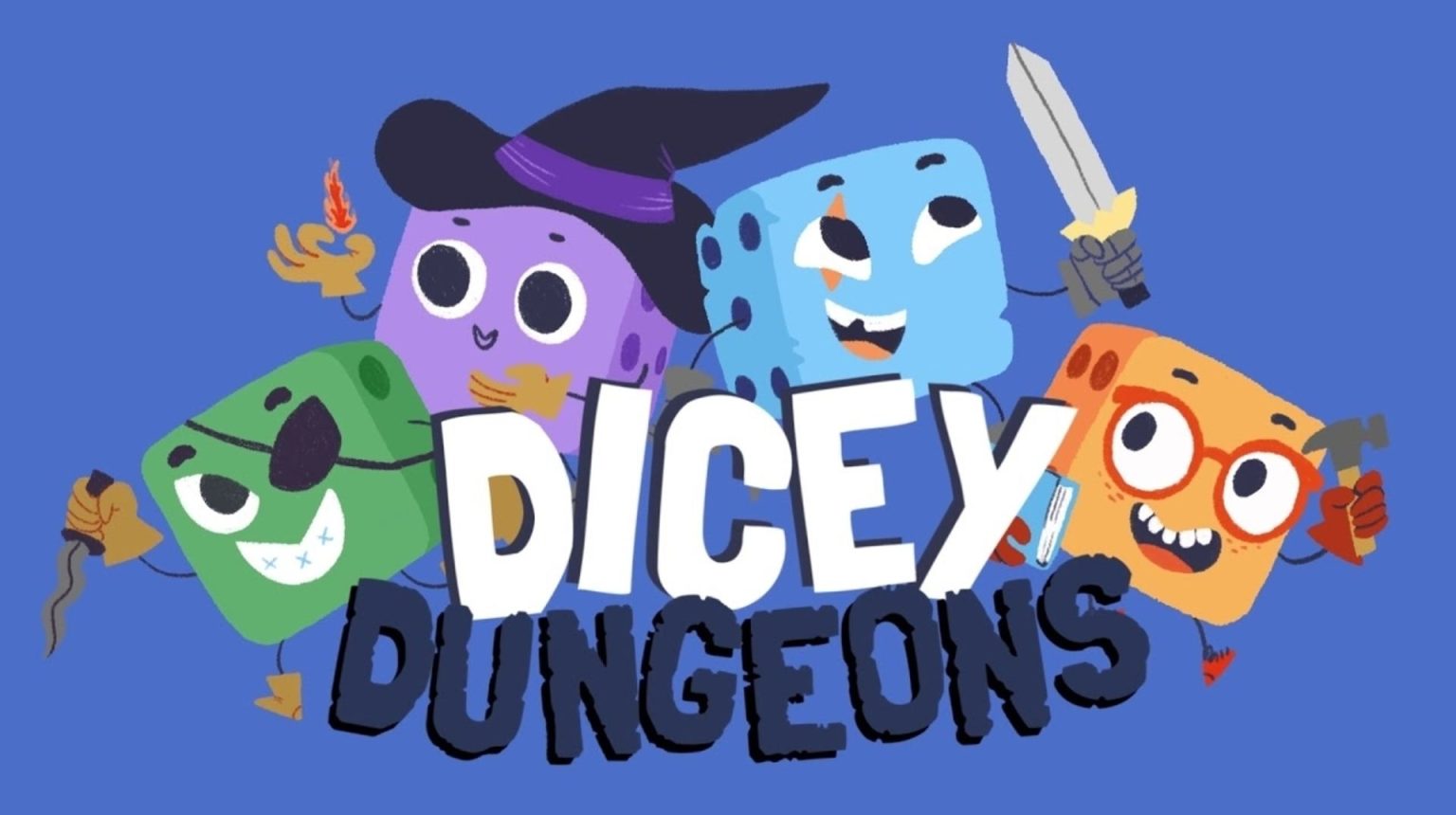What Happens in the Dungeon, Stays in the Dungeon… Forever.
Making its grand debut on Steam and itch.io, Dicey Dungeons opened to a rousing applause from its studio audience. Developed by Terry Cavanagh, the man who designed the cult-classic VVVVVV and entertaining Super Hexagon, Dicey Dungeons rolled a solid 5 out of 6 on Steam (83% user approval rating) within its first two weeks, with a good reroll on itch.io (4.8/5).
As a connoisseur of indie roguelites myself, I took to the game with the same fervor that I had when tackling games like Rogue Legacy or Risk of Rain, and found myself… a little surprised. At first glance, Dicey Dungeons seems to be just another RNG-heavy indie to join the mass of roguelites flooding the Steam library. While a lot of its themes are similar to games of the genre, Cavanagh rolled the dice a different way: Rather than having a single, randomly generated map that players slowly progress through, Dicey Dungeons produces an episodic format of gameplay, wherein each of the game’s playable characters has six different events to go through. So, while it’s like a lot of roguelites in that you still have randomized encounters, battles, and maps, you generally know what to expect when you click one of a character’s episodes.
So, let’s try and unveil Lady Luck’s scheme by rolling high and jamming out.
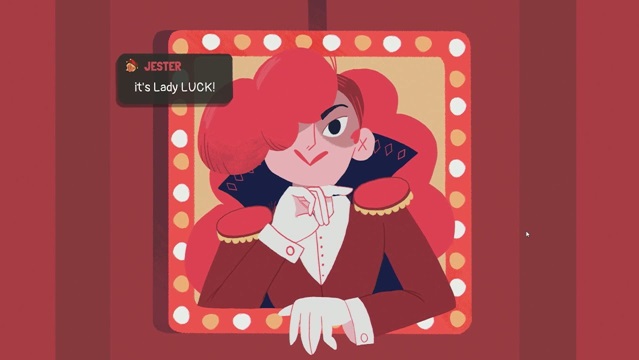
The Story: Roll-Playing
The story is simple: Lady Luck, shown above, has offered a tantalizing prize — whatever the heart desires — to anyone who can beat her game show “Dicey Dungeons.” In search of various spoils, six volunteers are turned into anthropomorphic dice and sent into the dungeon to fight it out with baby squids, awkwardly fit snowmen, and other odd monstrosities. Each of the game’s participants believe they are about to win it big and be set for life; however, they keep crit-failing, and the wheel of fortune never seems to grant them their wish…
While it is not expressly stated whether Lady Luck is evil or not, she does tend to be rather callous towards her contestants and dungeon-dwelling monsters. This is primarily played for laughs; the dialogue between Lady Luck and her unfortunate contestants is condescending, yet charming. She’s a villain, through and through, but she’s a captivating one, and that’s what I love about her.
The six playable characters, or contestants, each have a distinct personality. The Warrior is your typical meathead; the Thief thinks he’s going to easily win the whole competition, and refuses to back down; the Robot is a smarty-pants who wants to remove the need to sleep from its life; etc. Their dialogue evolves based on the completion of their episodes, from pure naivety to slow realization of their eternal damnation, and how each victim reacts to their own fate (whether by optimism, disillusionment, or confusion) is kept on-character and well-written throughout.
This can also be said for the contestants’ enemies, which are occasionally given lines of dialogue upon being defeated in combat. It’s an interesting, random reward for continuously clearing fights, and one that I find myself constantly excited to see occur. Getting even a little bit more insight into this odd fantasy dungeon is intriguing, since Cavanagh generally keeps the origins of the dungeons and characters out of the player’s reach. There are even unlockable bits of lore about individual enemies, in the form of a survey about where the enemy came from, why they came into the dungeon, and even what they like. All fun bits of character building that don’t really factor into the game, but it’s nice to have dialogue that shows the designer’s love for each element of design.
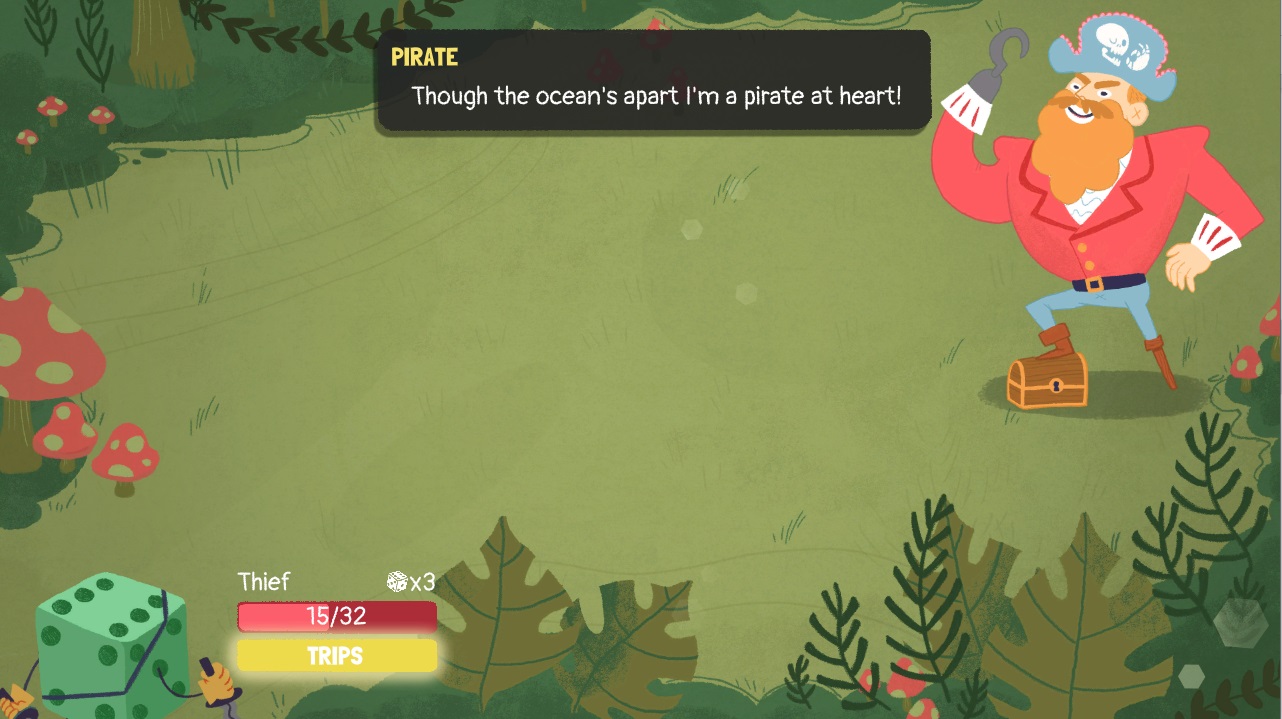
Dicey Dungeons’ story rolls a 5 out of 6 for me. While it isn’t an integral part of the experience, and as such there isn’t much focus on it, it’s still a wonderful side addition that kept me entertained from start to finish.
The Gameplay: Let’s Roll Out
Gameplay in Dicey Dungeons is divided into two segments: moving around an overworld and fighting enemies. In the overworld, the player collects apples to heal; spends currency at shops; swaps out “equipment,” or abilities, at trading posts; and upgrades current equipment at anvils. Maps consist of a series of connected nodes, each of which is either empty or houses an enemy, healing item, shop, trading post, or anvil. Unlike many other roguelikes, maps in Dicey Dungeons are not procedurally generated, but rather chosen from a fixed number of pre-existing templates.
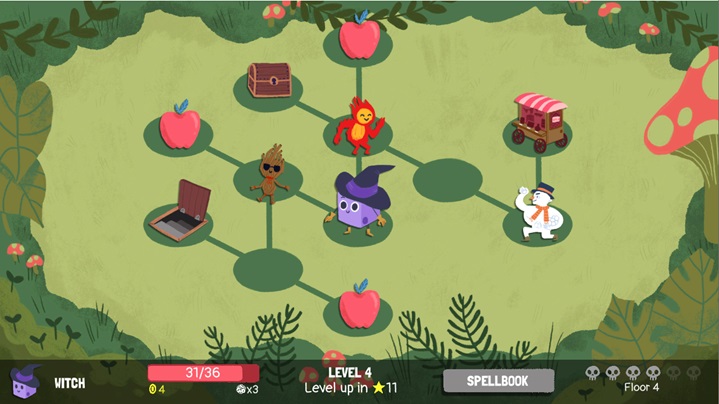
Battles with enemies take place in the form of turn-based combat. Your player character, and all enemies, have pieces of equipment that have varying dice costs. At the beginning of your turn, your character rolls as many dice as it currently has, either based on current level or class. By slotting your dice into the equipment, you can activate the equipment to deal damage, heal, block damage, apply a damage-reflecting shield on yourself, probably make you pizza or something… The list goes on. Each character has starting equipment and a special, class-based ability (that they can’t unequip, but typically is super strong!) to fight the first few enemies with, and each of the six episodes are crafted to provide each class several different equipment synergies, to keep reruns interesting.
After defeating enemies, the player is rewarded with a coin (the currency players can spend at shops for randomized equipment, upgrades, or healing) and experience. Upon leveling up, the player is fully healed; receives a maximum-health increase; and is occasionally given an additional die, new piece of equipment, or gear upgrade. And so it goes, down until the last floor, where there is an epic boss fight.
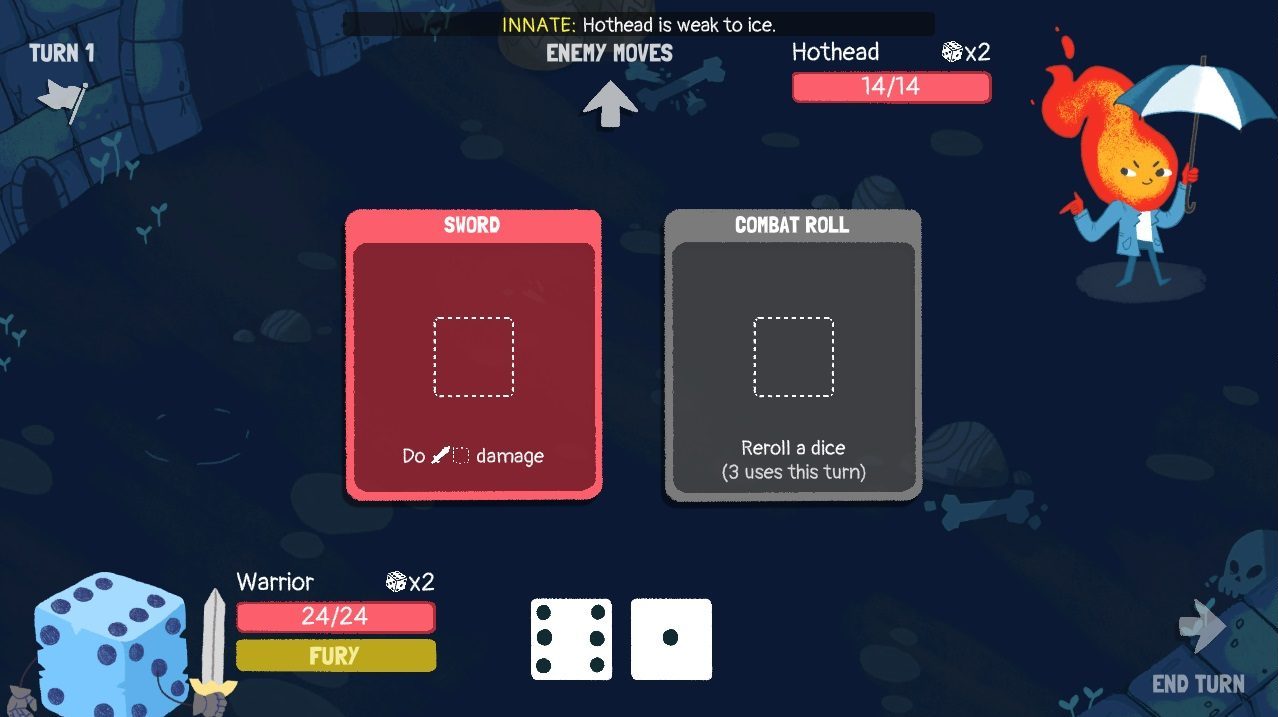
Status effects are a major part of any character’s run. For example, when a character is inflicted with “Burn,” its dice are lit on fire. If you try and use the dice, you take 2 damage, and the dice are extinguished. “Freeze,” meanwhile, lowers your highest-rolled die to a paltry 1; “Shocked” keeps one of your abilities behind shackles, requiring you to give up one of your dice that turn if you want to unlock it; and so on. The contestants can inflict statuses back on their opponents, too, so long as they have the right equipment.
Some of these rules can change, mind you, depending on the episode you are doing. For example, for the second episode of the Warrior class, all equipment is automatically upgraded, and you start with really strong stuff! But, you are always cursed, so there’s a 50% chance that your equipment will not work. (Thankfully, after the first time it doesn’t work, you aren’t cursed for the rest of the turn.)
Dicey Dungeons is somewhat unique, in that it is one of the few roguelites that is almost completely reliant on RNG. Gambling isn’t a concern here — recent industry trends like loot boxes and pay-to-win upgrades are nowhere to be found in the game. What is concerning, however, is that if I roll poorly in combat, I can’t deal damage, but if Sneezy rolls a 6, he can deal upwards of 12 to my small health pool. That means that, sometimes, Dicey Dungeons can put players into the frustrating situation where there’s nothing they can do except lose the run. Lose a run like this a few times, and… Well, it can be a game that you occasionally need to put down and do something else. This is certainly the case for the more luck-oriented classes, like the Robot, who plays pseudo-Blackjack to determine how many, and what quality of, dice you will be getting for your dice pool.
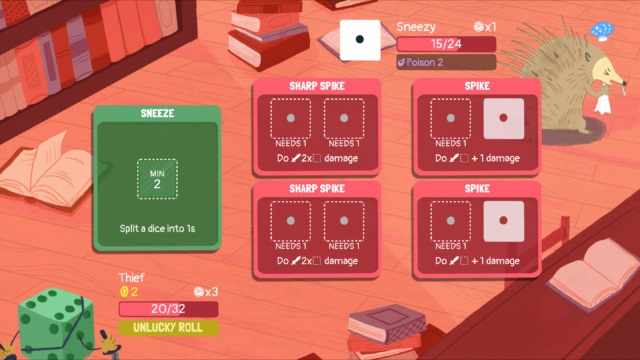
This far from kills the game, however. As frustrating as it can be to lose a good run to bad rolls, it can be just as heartening to save a dying run with good rolls, or to absolutely destroy an episode that was giving you trouble with a combination of better gear, rolls, and strategy. There are two sides to every coin… And, well, this die has six. And three of them are reserved for being murdered by awkwardly fit snowmen freezing you to death.
A concern that I commonly see within the comments of Dicey Dungeons’ Steam user review library (among classics like “this cured my cancer” and “this gave me cancer”) is that it isn’t like a traditional roguelite. The maps aren’t super randomized, each episode gives abilities from a relatively small pool of possible options, and the rules don’t change within the same episode.
While I believe this may hurt this game’s replay value in the long run, I don’t see why this warrants a negative review. To the contrary, I think the game’s unique style of organizing gameplay is an interesting experiment in game balance and shaking up the established formula. It is absolutely fine to not like Dicey Dungeons if it’s “not your style,” but not liking it because it doesn’t fit the pixel-perfect definition of a roguelite seems rather short-sighted.
…Just dislike the game because the Marshmallow guy hit you for 11 with a perfect roll like the rest of us.
Gameplay rolls a 5 because, despite the incredibly strong combat system and interesting map decision-making, losing because of bad luck feels bad, plain and simple.
The Aesthetics: Rock n’ Roll
As expected from the mind behind VVVVVV, the music and sound design of Dicey Dungeons is outstanding. The soundtrack is a wonderful mix of retro and modern styles, combining the feeling of an on-stage band performance with the synthy chiptunes of old-school gaming. With all the nostalgia-inducing sound effects, bumpin’ showtunes, sounds of the audience, and personalized reactionary effects coming from each of the “actors,” you’re sure to find yourself immersed in the game just after starting a run.
Dicey Dungeons’ art employs a cutesy, almost crayon aesthetic, which works well for the fun atmosphere and rollin’ soundtrack. The art style was designed with a cartoonish look at the forefront, and makes a clear effort to ensure that each character matches their personality, while staying simplistic. All in all, the art makes for an excellent compliment to Dicey Dungeons’ music and general themes.
Aesthetics roll a perfect 6 out of 6.
Final Thoughts
While Dicey Dungeons’ RNG elements can get frustrating (I lost my last run by taking 20 damage in one turn from a lucky enemy roll), the enjoyable art style, lovable music, memorable characters, and familiar rush of getting that one, perfect run keeps me coming back. Every aspect of this game oozes not only flavor, but clear passion for the project and a love of roguelite RPGs as a whole — all while changing the traditional roguelike formula by adding set rules in an episodic format. If you enjoy snarky characters, nail-biting strategy, and rolling dice, then may Lady Luck guide you to a realm of your wildest dreams… Maybe not for eternity, but for a long, fun time.
This game rolls a 5 out of 6.
Jason graduated from Northeastern University with a degree in English and Game Design. For him, video games are not just an art form, but one of the greatest mediums to tell a story.
When not perpetuating the game journalist stereotype of being awful at a game and blaming the game for it, Jason likes writing short fiction novels that never get past chapter two, and playing Dungeons & Dragons.


